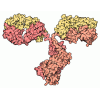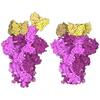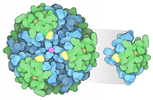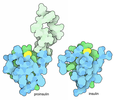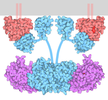[English] 日本語
 Yorodumi
Yorodumi- PDB-5j3h: Human insulin receptor domains L1-CR in complex with peptide S519... -
+ Open data
Open data
- Basic information
Basic information
| Entry | Database: PDB / ID: 5j3h | |||||||||||||||
|---|---|---|---|---|---|---|---|---|---|---|---|---|---|---|---|---|
| Title | Human insulin receptor domains L1-CR in complex with peptide S519C16 and 83-7 Fv | |||||||||||||||
 Components Components |
| |||||||||||||||
 Keywords Keywords | HORMONE RECEPTOR/IMMUNE SYSTEM / Insulin receptor Insulin mimetic peptide Fv fragment / HORMONE RECEPTOR-IMMUNE SYSTEM complex | |||||||||||||||
| Function / homology |  Function and homology information Function and homology informationregulation of female gonad development / positive regulation of meiotic cell cycle / insulin-like growth factor II binding / positive regulation of developmental growth / male sex determination / insulin receptor complex / insulin-like growth factor I binding / positive regulation of protein-containing complex disassembly / insulin receptor activity / exocrine pancreas development ...regulation of female gonad development / positive regulation of meiotic cell cycle / insulin-like growth factor II binding / positive regulation of developmental growth / male sex determination / insulin receptor complex / insulin-like growth factor I binding / positive regulation of protein-containing complex disassembly / insulin receptor activity / exocrine pancreas development / dendritic spine maintenance / cargo receptor activity / insulin binding / adrenal gland development / neuronal cell body membrane / PTB domain binding / Signaling by Insulin receptor / IRS activation / positive regulation of respiratory burst / amyloid-beta clearance / positive regulation of receptor internalization / regulation of embryonic development / insulin receptor substrate binding / protein kinase activator activity / epidermis development / positive regulation of glycogen biosynthetic process / Signal attenuation / heart morphogenesis / transport across blood-brain barrier / phosphatidylinositol 3-kinase binding / Insulin receptor recycling / insulin-like growth factor receptor binding / dendrite membrane / neuron projection maintenance / positive regulation of mitotic nuclear division / Insulin receptor signalling cascade / receptor-mediated endocytosis / positive regulation of glycolytic process / positive regulation of D-glucose import / learning / receptor protein-tyrosine kinase / caveola / cellular response to growth factor stimulus / receptor internalization / memory / male gonad development / cellular response to insulin stimulus / positive regulation of nitric oxide biosynthetic process / insulin receptor signaling pathway / late endosome / glucose homeostasis / amyloid-beta binding / protein autophosphorylation / PI5P, PP2A and IER3 Regulate PI3K/AKT Signaling / protein tyrosine kinase activity / lysosome / positive regulation of canonical NF-kappaB signal transduction / positive regulation of phosphatidylinositol 3-kinase/protein kinase B signal transduction / receptor complex / endosome membrane / positive regulation of MAPK cascade / positive regulation of cell migration / G protein-coupled receptor signaling pathway / protein domain specific binding / axon / external side of plasma membrane / positive regulation of cell population proliferation / regulation of DNA-templated transcription / symbiont entry into host cell / GTP binding / positive regulation of DNA-templated transcription / protein-containing complex binding / extracellular exosome / ATP binding / identical protein binding / membrane / plasma membrane Similarity search - Function | |||||||||||||||
| Biological species |   Homo sapiens (human) Homo sapiens (human) Endothia gyrosa (fungus) Endothia gyrosa (fungus) | |||||||||||||||
| Method |  X-RAY DIFFRACTION / X-RAY DIFFRACTION /  SYNCHROTRON / SYNCHROTRON /  MOLECULAR REPLACEMENT / Resolution: 3.27 Å MOLECULAR REPLACEMENT / Resolution: 3.27 Å | |||||||||||||||
 Authors Authors | Lawrence, M. / Menting, J. / Lawrence, C. | |||||||||||||||
| Funding support |  Australia, 4items Australia, 4items
| |||||||||||||||
 Citation Citation |  Journal: J.Biol.Chem. / Year: 2016 Journal: J.Biol.Chem. / Year: 2016Title: Insulin Mimetic Peptide Disrupts the Primary Binding Site of the Insulin Receptor. Authors: Lawrence, C.F. / Margetts, M.B. / Menting, J.G. / Smith, N.A. / Smith, B.J. / Ward, C.W. / Lawrence, M.C. | |||||||||||||||
| History |
|
- Structure visualization
Structure visualization
| Structure viewer | Molecule:  Molmil Molmil Jmol/JSmol Jmol/JSmol |
|---|
- Downloads & links
Downloads & links
- Download
Download
| PDBx/mmCIF format |  5j3h.cif.gz 5j3h.cif.gz | 229.4 KB | Display |  PDBx/mmCIF format PDBx/mmCIF format |
|---|---|---|---|---|
| PDB format |  pdb5j3h.ent.gz pdb5j3h.ent.gz | 184 KB | Display |  PDB format PDB format |
| PDBx/mmJSON format |  5j3h.json.gz 5j3h.json.gz | Tree view |  PDBx/mmJSON format PDBx/mmJSON format | |
| Others |  Other downloads Other downloads |
-Validation report
| Summary document |  5j3h_validation.pdf.gz 5j3h_validation.pdf.gz | 1.4 MB | Display |  wwPDB validaton report wwPDB validaton report |
|---|---|---|---|---|
| Full document |  5j3h_full_validation.pdf.gz 5j3h_full_validation.pdf.gz | 1.4 MB | Display | |
| Data in XML |  5j3h_validation.xml.gz 5j3h_validation.xml.gz | 20.4 KB | Display | |
| Data in CIF |  5j3h_validation.cif.gz 5j3h_validation.cif.gz | 27.6 KB | Display | |
| Arichive directory |  https://data.pdbj.org/pub/pdb/validation_reports/j3/5j3h https://data.pdbj.org/pub/pdb/validation_reports/j3/5j3h ftp://data.pdbj.org/pub/pdb/validation_reports/j3/5j3h ftp://data.pdbj.org/pub/pdb/validation_reports/j3/5j3h | HTTPS FTP |
-Related structure data
| Related structure data | 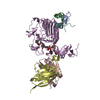 4ogaS S: Starting model for refinement |
|---|---|
| Similar structure data |
- Links
Links
- Assembly
Assembly
| Deposited unit | 
| ||||||||
|---|---|---|---|---|---|---|---|---|---|
| 1 |
| ||||||||
| Unit cell |
|
- Components
Components
-Antibody , 2 types, 2 molecules CD
| #2: Antibody | Mass: 13440.069 Da / Num. of mol.: 1 Source method: isolated from a genetically manipulated source Source: (gene. exp.)   Brevibacillus (bacteria) Brevibacillus (bacteria) |
|---|---|
| #3: Antibody | Mass: 13152.705 Da / Num. of mol.: 1 Source method: isolated from a genetically manipulated source Source: (gene. exp.)   Brevibacillus (bacteria) Brevibacillus (bacteria) |
-Protein/peptide / Protein , 2 types, 2 molecules BE
| #1: Protein/peptide | Mass: 1950.047 Da / Num. of mol.: 1 / Source method: obtained synthetically Details: 16 C-terminal residues of peptide S519: SER-LEU-ASP-GLU-SER-PHE-TYR-ASP-TRP-PHE-GLU-ARG-GLN-LEU Source: (synth.)  Endothia gyrosa (fungus) Endothia gyrosa (fungus) |
|---|---|
| #4: Protein | Mass: 36231.762 Da / Num. of mol.: 1 / Fragment: UNP residues 28-337 Source method: isolated from a genetically manipulated source Source: (gene. exp.)  Homo sapiens (human) / Gene: INSR / Production host: Homo sapiens (human) / Gene: INSR / Production host:  References: UniProt: P06213, receptor protein-tyrosine kinase |
-Sugars , 4 types, 5 molecules 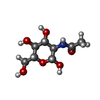
| #5: Polysaccharide | 2-acetamido-2-deoxy-beta-D-glucopyranose-(1-4)-[alpha-L-fucopyranose-(1-6)]2-acetamido-2-deoxy-beta- ...2-acetamido-2-deoxy-beta-D-glucopyranose-(1-4)-[alpha-L-fucopyranose-(1-6)]2-acetamido-2-deoxy-beta-D-glucopyranose Source method: isolated from a genetically manipulated source |
|---|---|
| #6: Polysaccharide | 2-acetamido-2-deoxy-beta-D-glucopyranose-(1-4)-2-acetamido-2-deoxy-beta-D-glucopyranose Source method: isolated from a genetically manipulated source |
| #7: Polysaccharide | 2-acetamido-2-deoxy-beta-D-glucopyranose-(1-2)-alpha-D-mannopyranose-(1-3)-[alpha-D-mannopyranose- ...2-acetamido-2-deoxy-beta-D-glucopyranose-(1-2)-alpha-D-mannopyranose-(1-3)-[alpha-D-mannopyranose-(1-6)]beta-D-mannopyranose-(1-4)-2-acetamido-2-deoxy-beta-D-glucopyranose-(1-4)-[alpha-L-fucopyranose-(1-6)]2-acetamido-2-deoxy-beta-D-glucopyranose Source method: isolated from a genetically manipulated source |
| #8: Sugar |
-Details
| Has protein modification | Y |
|---|
-Experimental details
-Experiment
| Experiment | Method:  X-RAY DIFFRACTION / Number of used crystals: 1 X-RAY DIFFRACTION / Number of used crystals: 1 |
|---|
- Sample preparation
Sample preparation
| Crystal | Density Matthews: 5.2 Å3/Da / Density % sol: 76.33 % |
|---|---|
| Crystal grow | Temperature: 300 K / Method: vapor diffusion, sitting drop / Details: 1.75 M (NH4)2HPO4 |
-Data collection
| Diffraction | Mean temperature: 100 K |
|---|---|
| Diffraction source | Source:  SYNCHROTRON / Site: SYNCHROTRON / Site:  Australian Synchrotron Australian Synchrotron  / Beamline: MX2 / Wavelength: 1 Å / Beamline: MX2 / Wavelength: 1 Å |
| Detector | Type: ADSC QUANTUM 315r / Detector: CCD / Date: Jul 1, 2015 |
| Radiation | Protocol: SINGLE WAVELENGTH / Monochromatic (M) / Laue (L): M / Scattering type: x-ray |
| Radiation wavelength | Wavelength: 1 Å / Relative weight: 1 |
| Reflection | Resolution: 3.27→34.79 Å / Num. obs: 21483 / % possible obs: 99.4 % / Redundancy: 6.3 % / Biso Wilson estimate: 85.67 Å2 / Net I/σ(I): 7.68 |
| Reflection shell | Resolution: 3.27→3.39 Å / Redundancy: 6.38 % / Rmerge(I) obs: 2.23 / Mean I/σ(I) obs: 1 / % possible all: 98.9 |
- Processing
Processing
| Software |
| ||||||||||||||||||||||||||||||||||||||||||||||||||||||||||||||||||||||||||||||||||||||||||||||||||||||||||||||||||||||||||||||||||||||||||||||||||||||
|---|---|---|---|---|---|---|---|---|---|---|---|---|---|---|---|---|---|---|---|---|---|---|---|---|---|---|---|---|---|---|---|---|---|---|---|---|---|---|---|---|---|---|---|---|---|---|---|---|---|---|---|---|---|---|---|---|---|---|---|---|---|---|---|---|---|---|---|---|---|---|---|---|---|---|---|---|---|---|---|---|---|---|---|---|---|---|---|---|---|---|---|---|---|---|---|---|---|---|---|---|---|---|---|---|---|---|---|---|---|---|---|---|---|---|---|---|---|---|---|---|---|---|---|---|---|---|---|---|---|---|---|---|---|---|---|---|---|---|---|---|---|---|---|---|---|---|---|---|---|---|---|
| Refinement | Method to determine structure:  MOLECULAR REPLACEMENT MOLECULAR REPLACEMENTStarting model: 4OGA Resolution: 3.27→34.79 Å / Cor.coef. Fo:Fc: 0.9116 / Cor.coef. Fo:Fc free: 0.8871 / SU R Cruickshank DPI: 0.72 / Cross valid method: THROUGHOUT / σ(F): 0 / SU R Blow DPI: 0.725 / SU Rfree Blow DPI: 0.357 / SU Rfree Cruickshank DPI: 0.361
| ||||||||||||||||||||||||||||||||||||||||||||||||||||||||||||||||||||||||||||||||||||||||||||||||||||||||||||||||||||||||||||||||||||||||||||||||||||||
| Displacement parameters | Biso mean: 122.88 Å2
| ||||||||||||||||||||||||||||||||||||||||||||||||||||||||||||||||||||||||||||||||||||||||||||||||||||||||||||||||||||||||||||||||||||||||||||||||||||||
| Refine analyze | Luzzati coordinate error obs: 0.899 Å | ||||||||||||||||||||||||||||||||||||||||||||||||||||||||||||||||||||||||||||||||||||||||||||||||||||||||||||||||||||||||||||||||||||||||||||||||||||||
| Refinement step | Cycle: LAST / Resolution: 3.27→34.79 Å
| ||||||||||||||||||||||||||||||||||||||||||||||||||||||||||||||||||||||||||||||||||||||||||||||||||||||||||||||||||||||||||||||||||||||||||||||||||||||
| Refine LS restraints |
| ||||||||||||||||||||||||||||||||||||||||||||||||||||||||||||||||||||||||||||||||||||||||||||||||||||||||||||||||||||||||||||||||||||||||||||||||||||||
| LS refinement shell | Resolution: 3.27→3.43 Å / Total num. of bins used: 11
| ||||||||||||||||||||||||||||||||||||||||||||||||||||||||||||||||||||||||||||||||||||||||||||||||||||||||||||||||||||||||||||||||||||||||||||||||||||||
| Refinement TLS params. | Method: refined / Refine-ID: X-RAY DIFFRACTION
| ||||||||||||||||||||||||||||||||||||||||||||||||||||||||||||||||||||||||||||||||||||||||||||||||||||||||||||||||||||||||||||||||||||||||||||||||||||||
| Refinement TLS group |
|
 Movie
Movie Controller
Controller



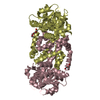

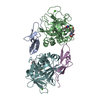
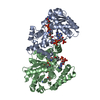



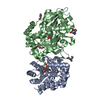
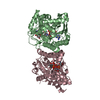
 PDBj
PDBj

